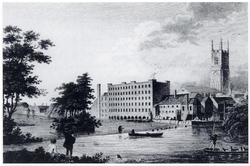Lombe's Mill

Lombe's Mill, viewed across the River Derwent, 18th century.
|
|
| Silk | |
|---|---|
| Alternative names | Italian Works |
| Structural system | brick |
| Owner | John Lombe |
| Coordinates | 52°55′32″N 1°28′32″W / 52.9256°N 1.4755°W |
| Construction | |
| Built | 1721 |
| Height | 17m |
| Floor count | 5 |
| Other dimensions | 33.5m x 12m |
| Water Power | |
| Diameter / width of water wheel | 7m / |
| Other Equipment |
|
Lombe's Mill was the first successful silk throwing mill in England. It was built on an island on the River Derwent in Derby. It was built after John Lombe visited Piedmont in 1717 and returned to England with details of the Italian silk throwing machines – the filatoio and the torcitoio – and some Italian craftsmen. The architect was George Sorocold.
Lombe's Mill was built next to Thomas Cotchett's 1704 mill on the west bank of the River Derwent in Derby. At this point a weir had been constructed across the river, and the mill was built on an island downstream which separated the river from the tail race of three corn mills. The tail race was also called a fleam or a leat. Derby was a key location as the river had a fast flow, and it was here that it was crossed by the London to Carlisle road
Lombe's Mill was the first successful silk throwing mill in England and probably the first fully mechanised factory in the world. Thomas Cotchett's mill, built in Derby in 1704, was a failure. John Lombe had visited the successful silk throwing mill in Piedmont in 1716, an early example of industrial espionage. He returned to Derby with the necessary knowledge and a group of Italians. He designed the mill, and with his half-brother Thomas Lombe (born 1685) instructed George Sorocold to build it and fit it with the new machines. It was built to the south of Cotchett's Mill.
Thomas Lombe was given a 14-year patent to protect the design of the throwing machines. The King of Sardinia reacted badly to the commercial challenge, placing an embargo on the export of raw silk. It is speculated that he was responsible for John Lombe's mysterious death, six years later, in 1722. John's elder brother, Thomas, took over the business. When the patents lapsed in 1732, other mills were built in and Macclesfield. An unpowered doubling shop was built to the north of the powered Italian works some time before 1739. The mill was sold to Thomas Wilson in 1739. An inventory was taken of the doubling shop, which still exists.
...
Wikipedia

